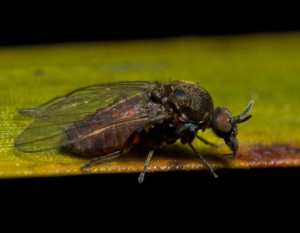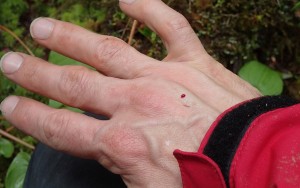Cattle flies (Simuliidae) is also called river mosquito and is a family of small mosquitoesthat suck blood from animals and humans. Only female mosquitoes bite and suck blood. This is because they need the blood to develop eggs.
In Denmark, people are most at risk of being bitten in May - especially if they are in the vicinity of cattle, where the vast majority of bites take place.
The bites from cattle midges can be serious in both humans and animals. In cattle, they can lead to abortion, stunted growth, reduced milk production and even death.
The bite of the cattle mosquito
Cattle flies bite both humans and animals. It's the female mosquitoes that bite because they need blood to develop their eggs. Mosquitoes are most active during the daytime, so this is usually when they bite. For the record, it should be noted that cattle mosquitoes do not bite - as many other mosquitoes do - but bite with their teeth.
The bite itself is superficial but can be serious on animals and humans alike. The mosquito's mouth contains anticoagulants that ensure the host's wound continues to bleed as long as the mosquito is sucking blood.
In animals such as In cattle, midge infestations can have a number of consequences for cattle - including abortion, stunted growth in young calves and reduced milk production in dairy cattle. If cattle are bitten enough times, they risk dying.
Some species of midges also crawl into body openings such as the ears, nose, eyes or navel to suck blood, which can be a problem for pets.
Bites on humans
The human reaction to a mosquito bite can be very individual, but often swelling, bleeding and fluid retention will occur. In some cases, an inflammatory or allergic reaction can also occur, and in more rare cases, the bite can also result in blood poisoning.
However, not all cattle midges bite humans; in the Simuliidae family, only 4 genera (Simulium, Prosimulium, Austrosimulium and Cnephia) contain human-biting species of cattle midge. The genus Simulium is the largest and most widespread.
In some parts of the world, cattle flies also spread diseases with their bites. This is the case, for example, in Africa and Central and South America, where they infect humans with river blindness (Onchocerciasis) and a number of other parasitic diseases. The disease-carrying cattle flies are all from the Simulium genus mentioned above.
The non-biting species of cattle midge can also be perceived as pests due to their tendency to swarm and disturb their surroundings.
Although a mosquito bite may not look too bad at first glance, in a short period of time it can cause swelling, bleeding and fluid retention - and in more severe cases, medical attention may be required
Treatment
Animals - such as cattle - should be brought into the barn to avoid further mosquito bites. The animal should be checked several times a day and in severe cases, a veterinarian should be contacted, who will typically treat the animal with antihistamines and possibly antibiotics.
If a person is bitten by a mosquito, they should contact a doctor. Often a phone call will determine whether or not medical attention is necessary. The minimal treatment is general wound care. In more severe cases, treatment with antihistamines and possibly antibiotics may be necessary. In rare cases where the bite results in blood poisoning, hospitalization is necessary.
Prevention
In Denmark, humans are most commonly bitten by cattle midges in May. The bites often occur in places where cattle are also present. To avoid the bites, you should therefore be particularly careful in the spring months - especially if you are in areas with cattle.
It's a good idea to use mosquito spray or other mosquito repellents during these periods. This also applies if you have observed bites from cattle mosquitoes on cattle you are working with during other times of the year. Note that it is often better to spray mosquito repellents on clothing rather than on the body, as this is more effective at keeping mosquitoes at bay.
The life cycle of the cattle midge
The length of the cattle fly life cycle depends on the species and the environment. In temperate regions, most species have 1 generation per year, while in tropical regions there are typically several generations per year. An example of a species with a very short development time would be Simuliidae damnosumwhich can complete its life cycle - i.e. develop from egg to egg-laying adult mosquito - in less than 2 weeks.
The eggs, larvae and pupae are found exclusively in moving water. The exact breeding sites are highly dependent on the species; some midges breed in places with waves (such as a lake shore), while others breed in almost stagnant water (such as forest lakes). A few species are found in water with a lot of movement, such as rivers and even waterfalls.
Cattle flies are found almost all over the globe, with the exception of some very cold regions and a few isolated islands.
Eggs
Egg layingEggs are typically laid in clusters of 200 - 300 with a minimum of 30 and maximum of 800. An adult female mosquito lays eggs approximately every 5 days, but some species do so at shorter intervals (as often as 24 hours). They are laid either on objects in the water (e.g. plants, wood or rocks), on the surface of the water or directly in the water so they sink to the bottom. No matter where they are placed, they are always in contact with water. Read more about the egg-laying process here.
Appearance: The eggs are 100 - 400 µm (micrometers) long and egg-shaped. They are covered in a jelly-like mass and are laid either in rows or messy piles. Freshly laid eggs are cream-colored, but they turn dark brown or black within 24 hours. Eggs are very sensitive to desiccation and will dry out if the relative humidity drops to 96% or below.
Hatching: The eggs hatch when the embryo is fully developed, which happens after a few days if conditions are favorable enough. However, there are some species where the eggs can go through an entire summer and/or winter without hatching.
Cattle midge larvae
Breathing: When the eggs hatch, the cattle midge larvae emerge. They breathe using feathery gills that can extract dissolved oxygen from the water.
CharacteristicsCattle midge larvae grow to 4 - 12 mm long and can easily be seen on underwater objects. They have a pair of "tabs" around their mouthparts that they use to capture algae, bacteria and small organic particles from the water (their food). At the other end, they have small hooks that they use to spin thin threads. These threads are used to drift in the water in search of a suitable place to settle (e.g. plants, rocks or wood). Once the location is found, the larvae use the threads again to attach themselves to the newly found object. The larvae can use the same technique to drift again to find a new object to attach to.
Territory: Some cattle midge species' larvae are territorial defenders and can be very aggressive towards other larvae in the vicinity. However, when food is abundant, territorial defense is significantly reduced. The concentration of larvae is often high at river outlets where the outlet water is rich in phytoplankton and other food items. The larvae may find a new habitat before entering the next stage, the pupal stage.
Tits
PrecursorMost species of cattle midge larvae spin a pupa in which they pupate. The development of the pupa starts inside the body of the individual larva, where a precursor to the final pupa is formed. The larva also develops a "gill spot" where you can often see a bit of the developing pupa through.
Doll: The pupa itself is shaped like a small slipper, with the closed end facing the current and the open end facing the direction of the current. This prevents the pupa from detaching. It takes the larva an hour to spin the final pupa, which is followed by a molt.
Pre-peeling: Once the caterpillar has pupated, it does not consume any kind of food. The pupa gradually becomes darker and darker as the caterpillar's development progresses. When the larva emerges from its pupa, the adult cattle moth floats up in a bubble of air and flies away as soon as it reaches the surface of the water. Alternatively, the cattle midge can also climb onto an object that protrudes above the water's surface to take off and fly away.
Adult cattle midges
ParringAlthough the vast majority of midge mating takes place in the air, it can also happen at actual mating sites and on animals (e.g. in the ears of cattle). Where mosquitoes mate depends partly on their species.
HostsThere are anatomical differences between cattle midges depending on whether they suck blood from birds or mammals (their hosts). For example, mosquitoes that suck blood from birds have serrations on their claws (which are used to hold onto the birds' feathers), which is not the case with the other group. However, many cattle midges suck blood from both birds and mammals. Each species also has their own individual preferences for which animals they will suck blood from. Some species can fly over 60 km from their hatching site in search of hosts.
BloodIt is only female mosquitoes that suck blood, but both sexes feed on nectar. Females can be divided into 3 groups: 1) females that do not need blood to develop eggs, 2) females that can develop their first batch of eggs without blood, but subsequently need blood to develop eggs and 3) females that need blood every time they develop eggs. The latter group is the most common. The bloodsucking itself lasts about 4-5 minutes.


